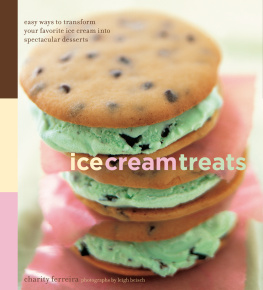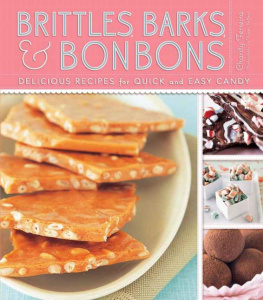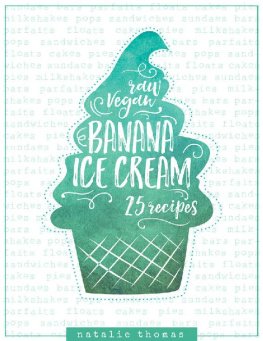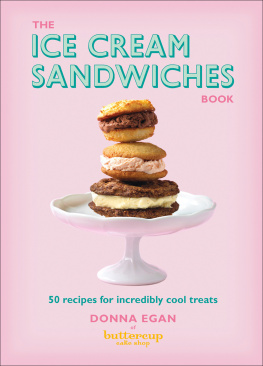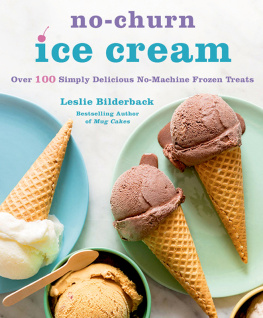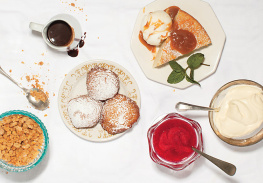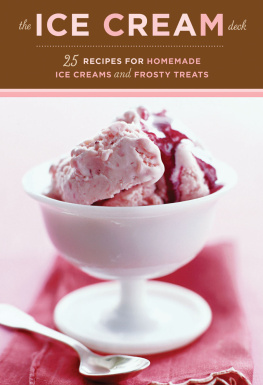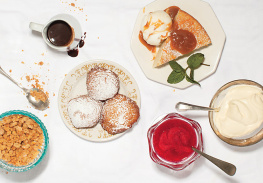
For Damon
Some very generous people helped me with this book. Many thanks to Rebecca Allswang, Lisl Hampton, Kelly Evans Pfeifer, and Sara Sens for their meticulous and enthusiastic recipe testing. Thanks also to my tireless cadre of tasters: Michael and Chris Ferreira; Damon, Rebecca, and Jackie Allswang; Cliff Ingham; and Michael Goorjian. I am especially indebted to Kate Washington, for sharing her unique ability to be both precise and inspired, and above all to Debbie Hughes, for keeping the hot lines open no matter how often I call.

When it comes to desserts, I have always been an ice cream person, in the way that some people are cake people while others yearn for fresh fruit pie. I became keenly aware of this when I worked at Greens restaurant in San Francisco, where I had the opportunity to assist Debbie Hughes, a brilliant and talented pastry chef with a highly evolved philosophy of ice cream.
Surrounded by beautiful raw ingredients, and hopped-up on caffeine and sugar, I learned at Greens that desserts can feed much more than just a craving for something sweet. They can be whimsical, intellectual, and fun. It goes without saying that a great dessert tastes delicious, but it also satisfies on other levels, whether because its beautiful, evokes a memory, or makes you smile in appreciation of its simplicity. And no desserts seem to do that as well as those involving ice cream.
The last several years have seen an amazing increase in both the variety and availability of high-quality store-bought ice cream. Although its hard to improve on the simplicity of a bowl of good ice cream, just a few deft additionsa fruit topping, a crumb crust, a chewy gingersnap, or a layer of butter caketurn purchased ice cream into special and evocative desserts.
The recipes in this book will show you how to use purchased ice cream to make cakes and pies, ice cream sandwiches, sundaes, layered parfaits, and drinks that range from homey to elegant, as well as homemade sauces and toppings to embellish them. Use your imagination to come up with your own creations. And if you want to try your hand at making your own ice cream, there are recipes for some classic flavorsdark chocolate, coffee bean, vanilla bean, and strawberryas well.
ice cream buyers guide
When buying ice cream at the supermarket, there are basically two kinds to choose between: premium and nonpremium. Although these denominations sound like they indicate quality, its more accurate to say they indicate the style of the ice cream, and which you choose is a matter of personal preference.
Premium ice cream (brands like Hagen-Daz, Ben & Jerrys, and Dreyers Dreamery) is most often sold by the pint, and is denser and richer than nonpremium ice cream. This is because it contains more solids and less air than nonpremium ice creams, such as Dreyers Grand and store brands, which have a lighter, softer texture. If you eat a lot of ice cream, youre probably familiar with the differences between these two types. If in doubt, compare the nutrition labels and the prices. Premium ice cream is more expensive, and it contains nearly twice the calories and fat of nonpremium ice cream.
Because nonpremium ice cream has more air, it softens more evenly and is easier to spread. However, for the same reason, it also melts faster. This can lead to iciness in the finished dessert if the ice cream melts too much as you work.
Some of the recipes in this book call for 3 pints premium or H gallon nonpremium ice cream. This is because nonpremium ice cream tends to pack down more when you soften and spread it. In an ice cream cake, 3 pints of premium ice cream will look like about the same volume as a H gallon of nonpremium.
A few of these recipes specify one type or the other, but most call for either. If the recipe does not specify a particular type, either will work.
A final note on a third type of ice cream: I love Philadelphia-style ice cream (which is made without eggs), such as Breyers, for eating in sundaes and parfaits. But I avoid using this kind of ice cream for ice cream cakes and pies. It tends to melt very quickly, which makes it difficult to work with and can give the cake or pie an icy texture.
tips and tools for perfect ice cream treats
before you begin
Check to make sure you have adequate room in your freezer for what you plan to make. You dont want to assemble a beautiful ice cream dessert only to have it melt while you make space for it in the freezer.
Have your work space clear and your tools and ingredients on hand before taking the ice cream out of the freezer to minimize the time the ice cream spends at room temperature.
Try to work with ice cream in a cool kitchen rather than one warm from the mid-day heat or the oven.
use the right tools for the job
While this wont always mean the difference between success and failure, it often makes the difference between a seamless experience and a frustrating one. Keep in mind that sometimes the most efficient tool for the job is a pair of clean hands; dont be afraid to use them! Here are a few other implements that will make assembly go smoothly.
OFF-SET SPATULAM This tool has a narrow angled blade with a rounded tip, which makes it easy to spread and frost the outsides of cakes evenly. Off-set spatulas come in several sizes6 and 8 inches are good all-purpose lengths. Shorter ones are handy for finer detailed work, or for spreading ice cream between cookies for ice cream sandwiches.
For spreading ice cream into a pie crust or cake pan, I use a triangular spatula with an angled metal blade. I think the one I favor is actually a pie server, but its short, wide blade makes it easy to exert enough pressure to spread stiff ice cream smoothly.
FLEXIBLE HEATPROOF SPATULA I use these spatulas for everything. They are indispensable for evenly scraping the bottom of a saucepan, and for folding dry ingredients into batter.
CHEFS KNIFE A large, heavy-duty knife is essential for cutting through frozen ice cream. A well-maintained chefs knife (my favorite is 8 inches) is as important for making desserts as it is for cooking savory foods; it is the best tool for chopping nuts and chocolate, and slicing ice cream cakes and pies.
PARCHMENT PAPER Baking parchment is sold in rolls at many grocery stores and baking supply stores. It keeps cookies from sticking while baking, and you can re-use the same piece for several batches of cookies.
BOWLS Use large bowls for mixing cake batters and cookie dough. A large bowl allows you to blend ingredients in fewer strokes without overworking the batter or dough, which is generally better for the texture of the finished product. I have a number of lightweight stainless-steel bowls in a variety of sizes, which work well for mixing or for melting chocolate over hot water.
PANS I avoid dark-colored baking pans and baking sheets (including those with dark nonstick finishes); they hold heat in a way that causes the edges of cakes and the bottoms of cookies to become darkly browned. I prefer stainless-steel, aluminum, or other light-colored metal bakeware, which generally result in more even browning. Most of the ice cream cake recipes in this book call for a 9- or 10-inch springform cake pan. These pans have a removable outer rim that closes tightly around a round base. Aluminum springform pans are quite inexpensive at restaurant supply stores; be sure to get one with a rim at least 2H inches tall.
Next page
